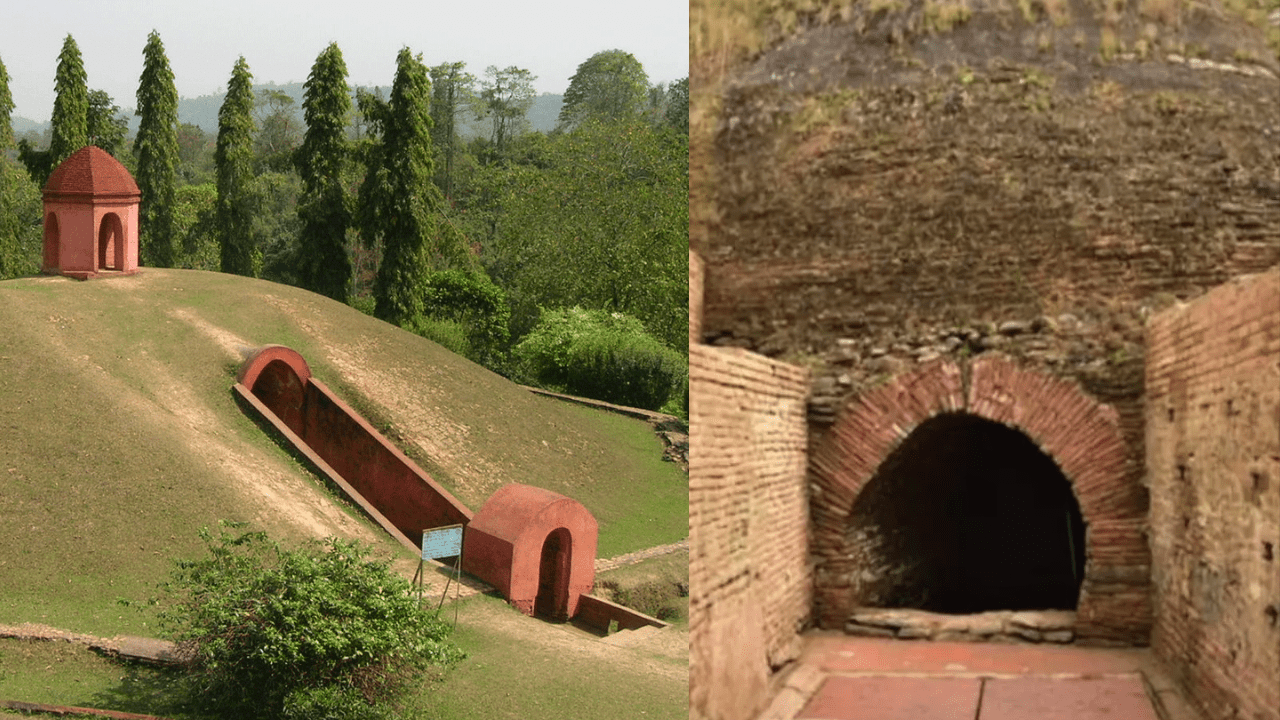The Legacy of the Moidams of Ahom Royals, Assam’s Moidams on the Brink of UNESCO World Heritage Status!

As Assam eagerly anticipates the potential designation of the Moidams of Ahom royals as a UNESCO World Heritage Site, the state stands on the cusp of international recognition for its rich cultural heritage. These ninety mound-shaped burial grounds, or ‘Moidams,’ located in the Charaideo district, embody the historical legacy of the Ahom dynasty and are poised to join the ranks of India’s celebrated heritage sites later this month.
The Road to UNESCO Recognition
The 46th ordinary session of UNESCO’s World Heritage Committee, scheduled to take place in New Delhi from July 21 to 31, holds special significance for Assam. The Moidams, which represent the only entry from India, are expected to receive the prestigious world heritage tag at this event. The International Council on Monuments and Sites (ICOMOS), an advisory body of UNESCO, has recommended the inclusion of Moidams in the world heritage list due to their exceptional cultural traditions and unique architectural and technological significance.
Assam’s Current UNESCO World Heritage Sites
Currently, Assam boasts two UNESCO World Heritage Sites: Kaziranga National Park, renowned for its habitat of the endangered one-horned rhinos, and Manas National Park, a biodiversity hotspot known for its spectacular scenery and natural landscape. The addition of the Charaideo Moidams would enrich Assam’s cultural heritage and diversify its offerings to tourists and heritage enthusiasts alike.
The Cultural and Historical Significance of Moidams of Ahom Royals
The Moidams of Assam are not merely burial mounds; they are emblematic of the state’s profound cultural heritage. These earthen mounds serve as the final resting places for kings, queens, and members of the royal family of the Ahom dynasty. The Ahom dynasty, founded by Chaolung Sukaphaa in 1228, ruled Assam for nearly six centuries until the region was annexed by the British East India Company following the Treaty of Yandaboo in 1826.
Chaolung Sukaphaa, a Shan (Tai) prince from Mong Mao in Yunnan, China, established the Ahom kingdom after crossing the Patkai Mountains via Myanmar. The Ahom royals were traditionally buried at Charaideo, the first capital of the Ahom kingdom, located approximately 28 kilometers from Sivasagar. Of the 386 Moidams explored so far, 39 are believed to be of Ahom kings.

The Unique Burial Practices of the Ahom Dynasty
The burial practices of the Ahom dynasty reflect their unique cultural traditions. Unlike the above-ground pyramids of Egypt, the Moidams are intricate structures situated beneath dome-shaped earthen mounds. These burial sites often contain items of daily use, clothing, and treasures such as gold, silver, coins, and ornaments, offering a glimpse into the lives and customs of the Ahom royals.
The term ‘Moidam,’ which in the Tai language means ‘place where the dead are worshipped,’ signifies the reverence the Ahoms had for their deceased. The first Moidam, as recorded in the historical chronicles known as ‘buranjis,’ was constructed for Sukaphaa by his eldest son at the foothills of Charaideo. This practice continued throughout the dynasty, creating a rich tapestry of history and culture that is encapsulated in these burial mounds.
The Anticipated UNESCO Tag and Its Impact
The potential UNESCO designation of the Charaideo Moidams as a World Heritage Site is expected to have a significant impact on Assam’s tourism and cultural preservation efforts. Padma Shri awardee Dutta emphasized the importance of adequate publicity once the UNESCO tag is granted. This recognition will not only boost the state’s tourism industry but also shine a spotlight on Assam’s culture and history, attracting visitors from outside the northeast region.
Birendra Kumar Gohain, an authority on the Ahom dynasty, echoed these sentiments, highlighting that the UNESCO tag would lead to better conservation efforts for the Moidams. He also noted the importance of ensuring proper publicity and encouraging tourists to explore other historical sites in Assam, such as Talatal Ghar, Rang Ghar, and Shiva Doul in the Sivasagar district.
Preserving and Promoting Assam’s Cultural Heritage
The UNESCO recognition of the Moidams would mark the first cultural heritage site in northeast India to receive such an honor. This milestone would not only acknowledge the historical and architectural importance of the Moidams but also enhance efforts to preserve and promote Assam’s rich cultural heritage. The increased awareness and tourism would provide opportunities to educate visitors about the Ahom dynasty, their burial practices, and the broader cultural landscape of Assam.
The comparison of the Moidams with the pyramids of Egypt by Gohain underscores their unique cultural significance. While the Egyptian pyramids are monumental structures above ground, the Ahom Moidams are intricate and equally impressive structures located beneath earthen mounds. This unique characteristic sets the Moidams apart and highlights the ingenuity and craftsmanship of the Ahom people.
The Broader Implications for Assam
The UNESCO tag for the Charaideo Moidams would bring broader awareness to other historical sites in Assam, fostering a greater appreciation for the state’s rich cultural heritage. As visitors flock to the newly designated World Heritage Site, they will also have the opportunity to explore the food habits and culture of other Assamese communities, further enriching their experience and understanding of the region.
Summary
As Assam awaits decision of the UNESCO World Heritage Committee, the anticipation surrounding the Charaideo Moidams reflects the state’s deep respect for its cultural heritage. Potential recognition of the Moidams as a UNESCO World Heritage Site isn’t only a tribute to Ahom dynasty and their unique burial practices but also a significant step towards preserving and promoting Assam’s rich history. The Moidams stand as a testament to the enduring legacy of the Ahom royals and the vibrant cultural traditions that continue to shape Assam today. As we await the official announcement, hope is that the Charaideo Moidams will soon join the ranks of the world’s most treasured heritage sites, bringing global recognition to Assam’s cultural and historical heritage.
Credit: This article is based on information first reported by Hindustan Times.
Read Next:

The Psychology of Love: Why Valentines Day Matters More Epic Than You Think
Discover the psychology of love and why Valentines Day is more important than you think. Learn how love impacts the brain, strengthens relationships, and boosts

Premier League Highlights: Arsenal Humiliate Man City 5-1, Spurs and Palace Secure Crucial Wins
Arsenal demolished Manchester City 5-1 in a statement premier league highlights win, reigniting their title hopes. Meanwhile, Crystal Palace stunned Man United 2-0, and Tottenham

How Budget 2025 Impacts the Indian Middle-Class: Major Tax Benefits and Glaring Omissions
Budget 2025 offers major tax relief to the middle class, including zero tax on incomes up to ₹12 lakh. However, it misses out on incentives

Degrees vs Employability: Why “Highly Qualified Degree Holders” Struggle to Find Jobs While “Less Qualified Individuals” Get Hired Faster!
Many highly qualified individuals struggle to secure jobs, while less qualified candidates get hired quickly. This Degrees vs Employability paradox is caused by employer preferences,

The Power of Mindset: Why Looking Poor Doesn’t Make You Poor, but Thinking Poor Does!
Discover why looking poor doesn’t define your wealth but thinking poor does. Learn the power of mindset and how a growth-oriented mindset can lead to

Overthinking: How It’s Damaging Today’s Youth – Causes and Cure in 2025
Understanding how overthinking is silently damaging today’s youth, from its causes rooted in societal pressure and social media to its long-term effects on mental health.
